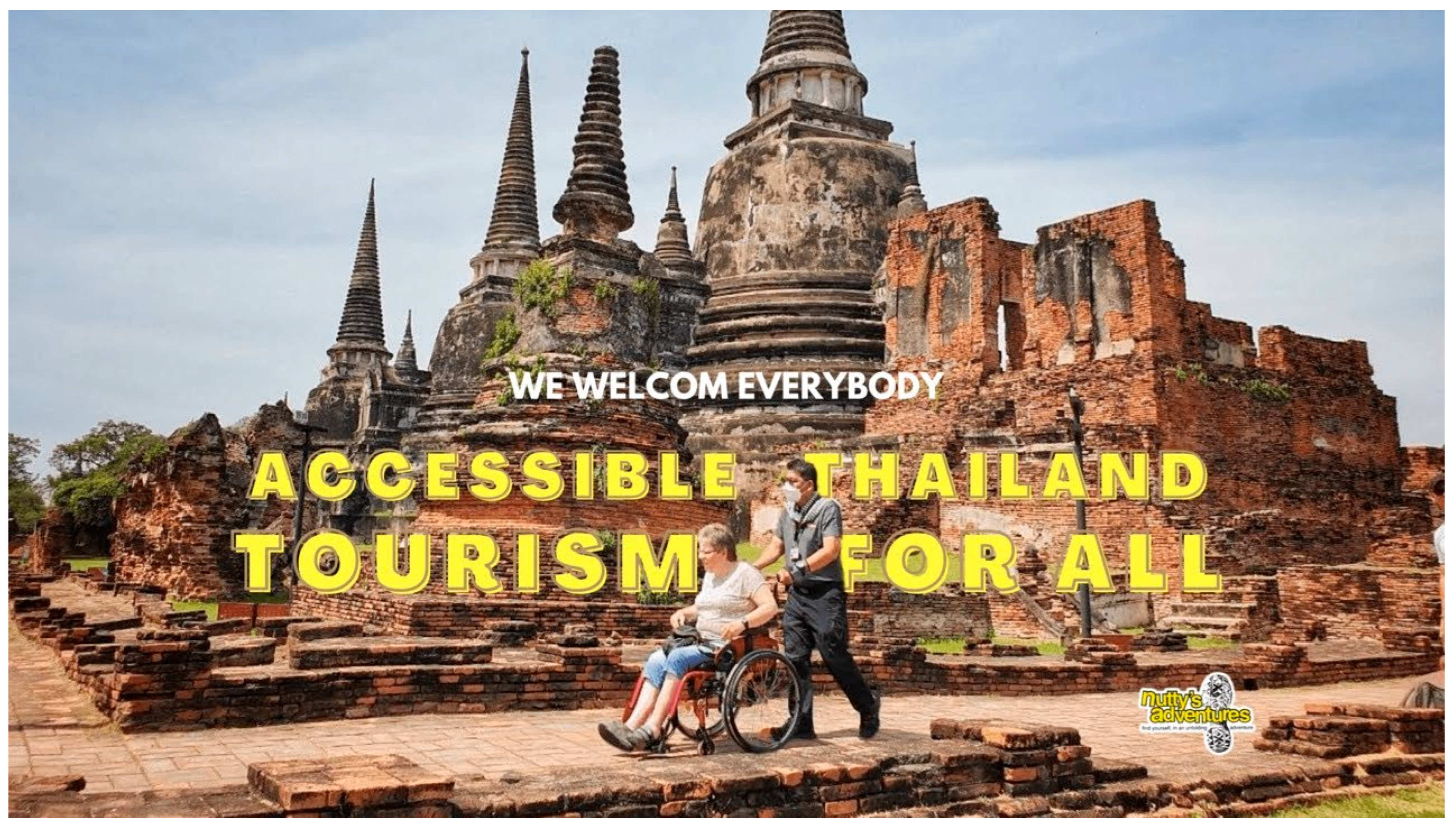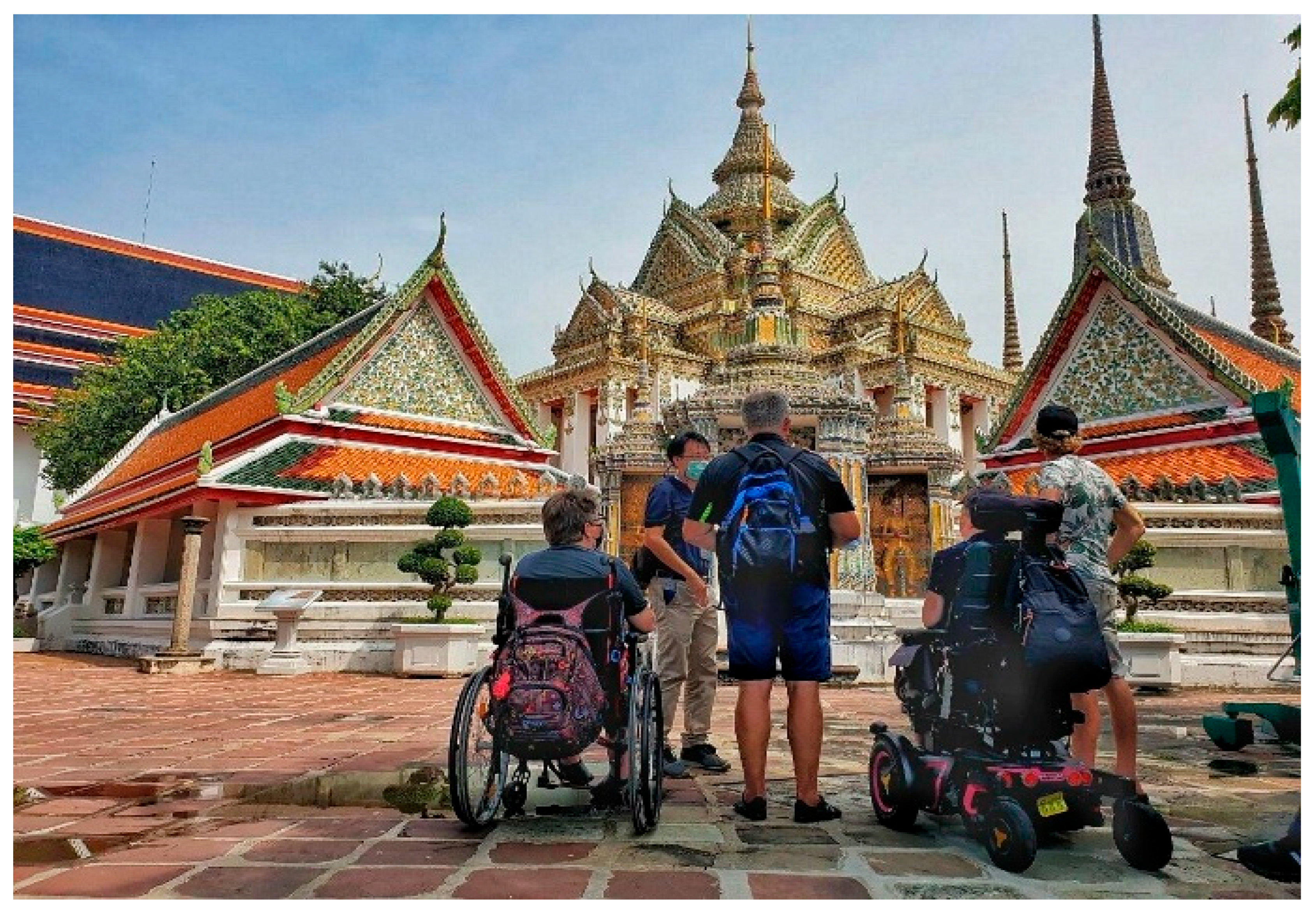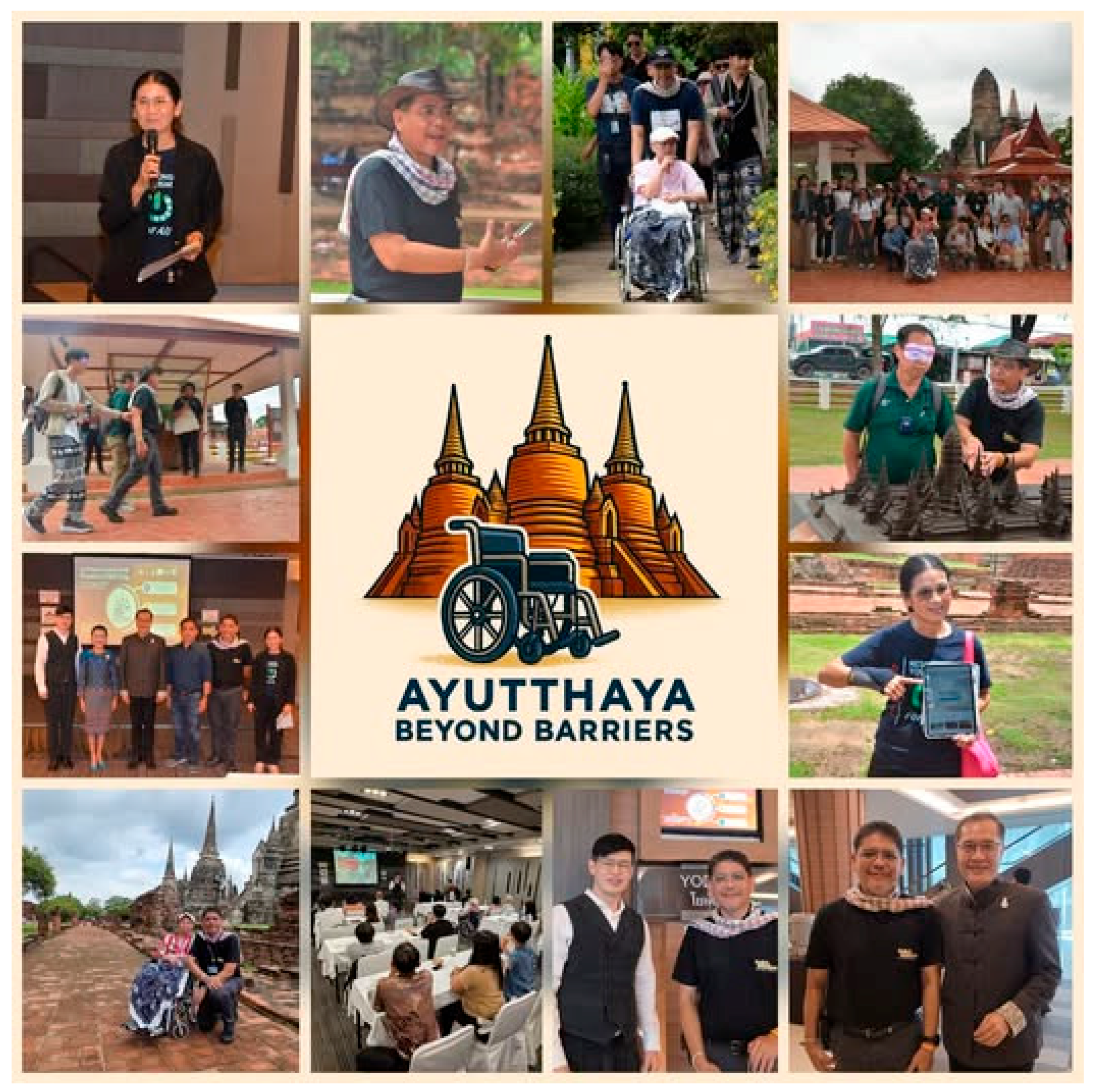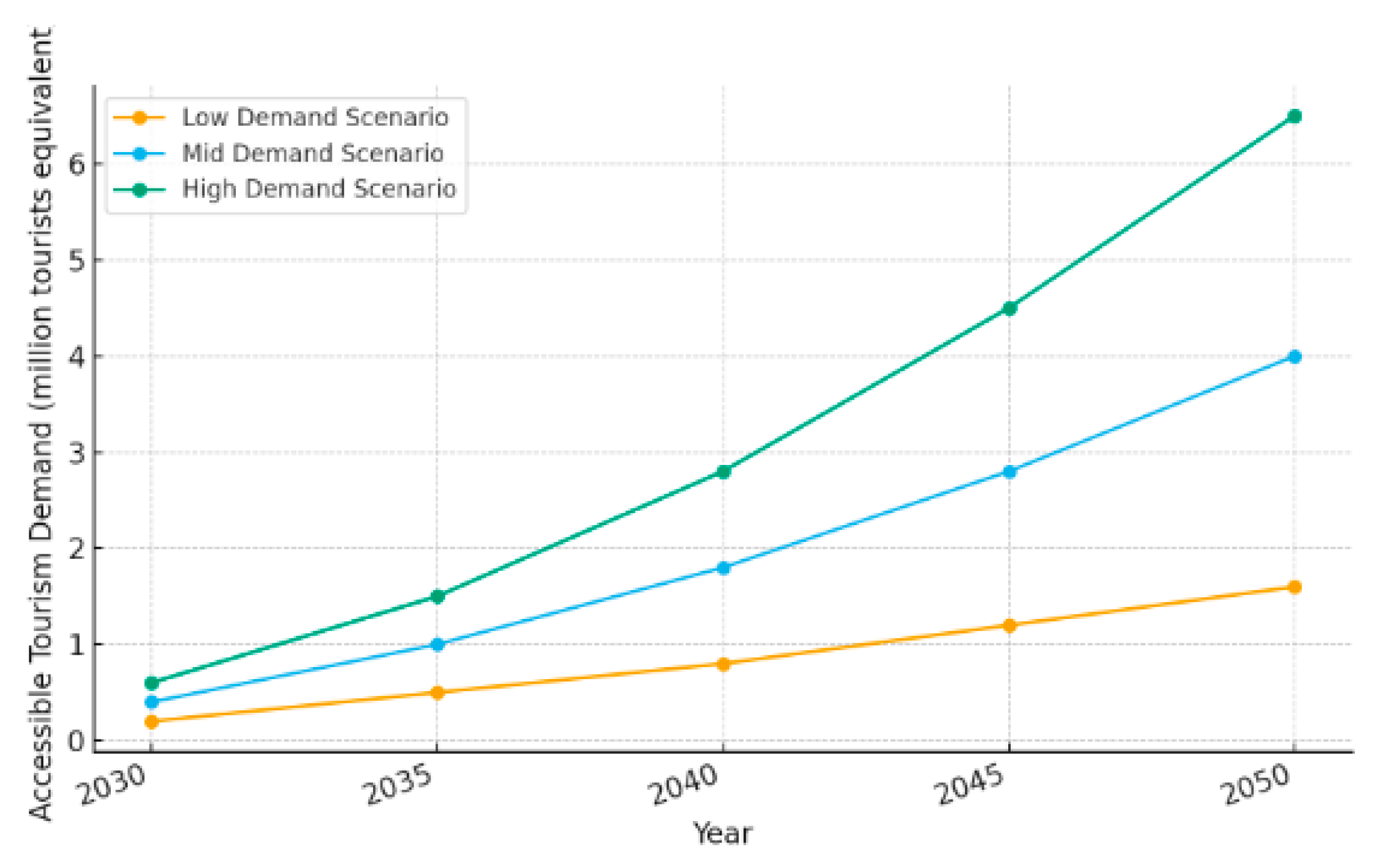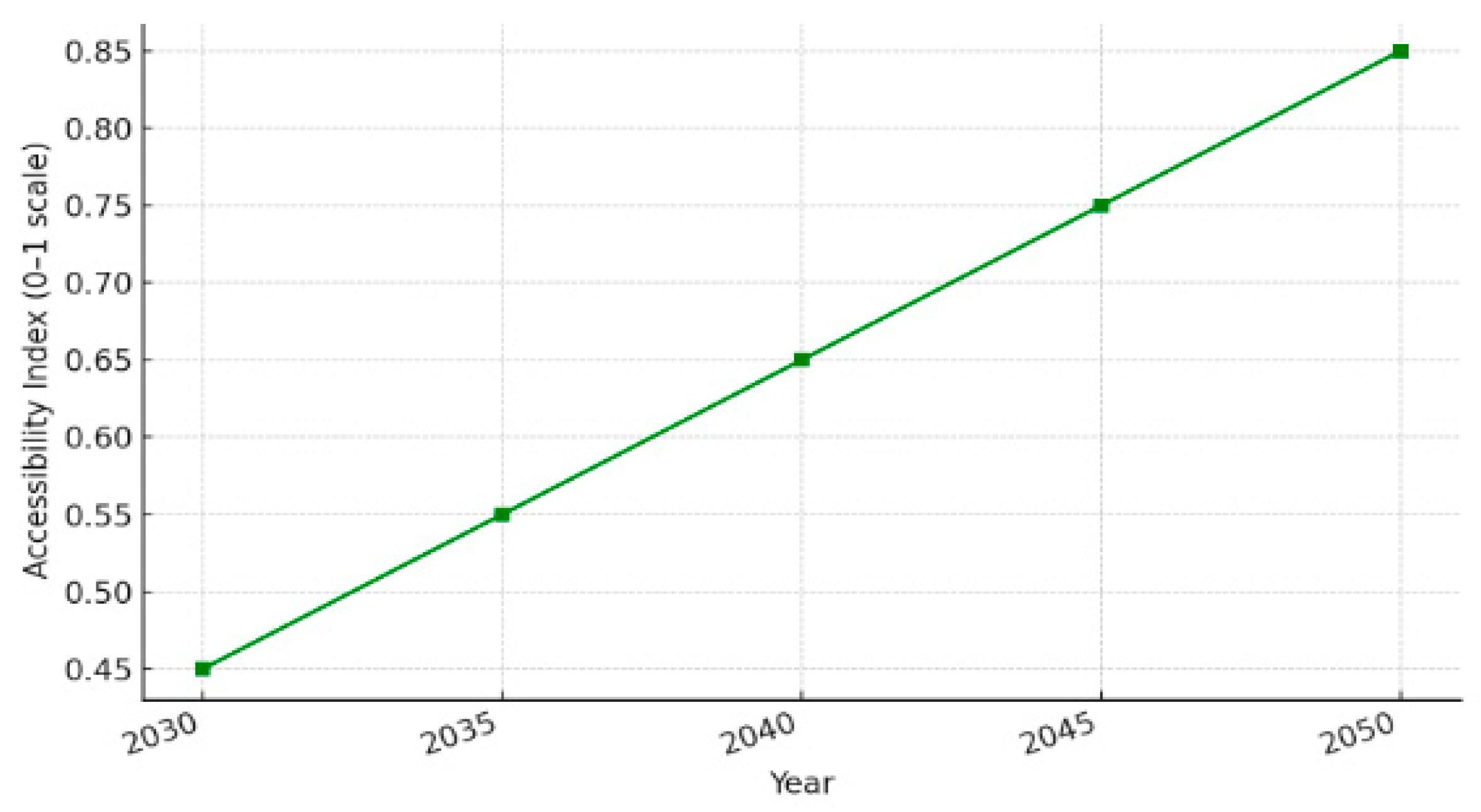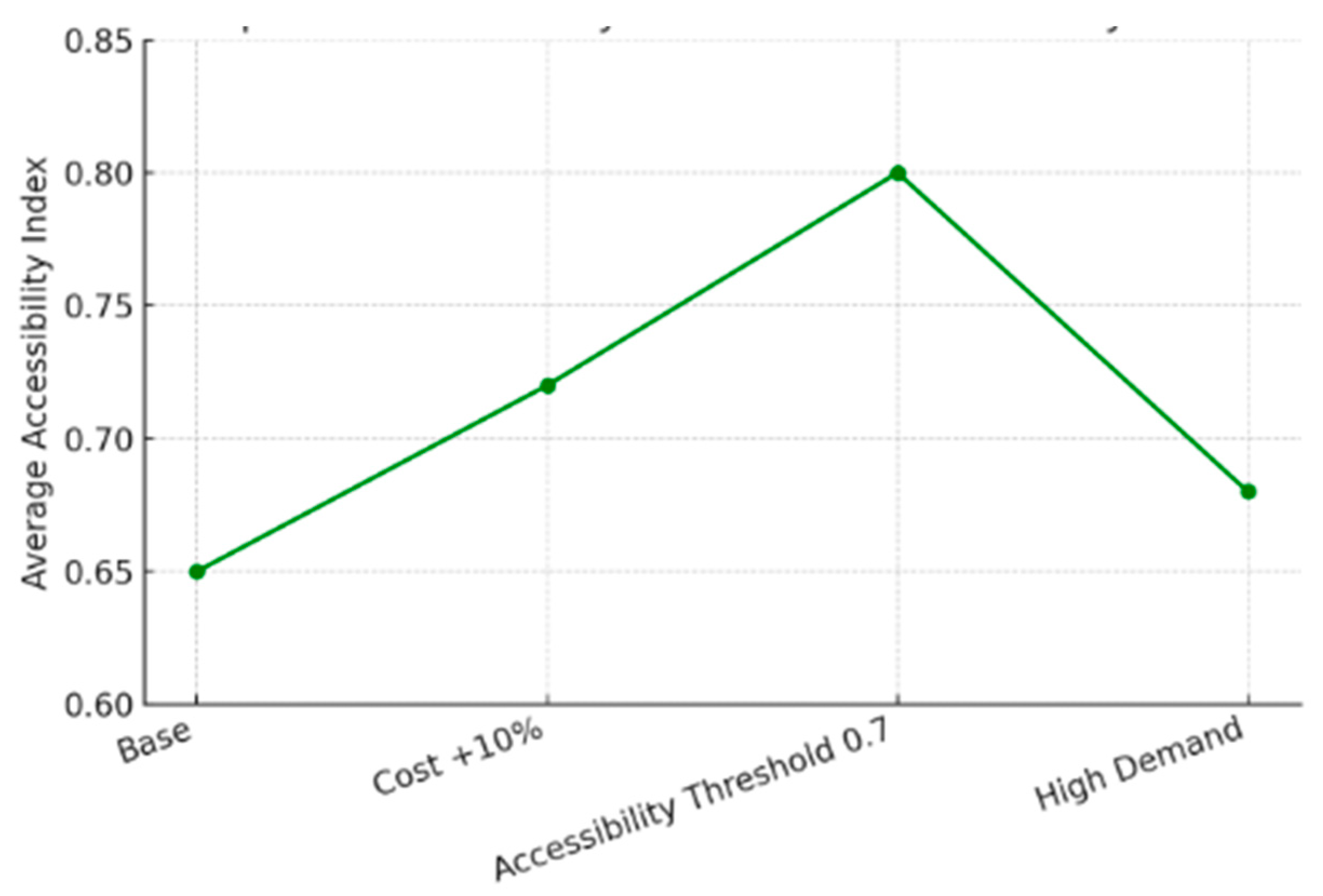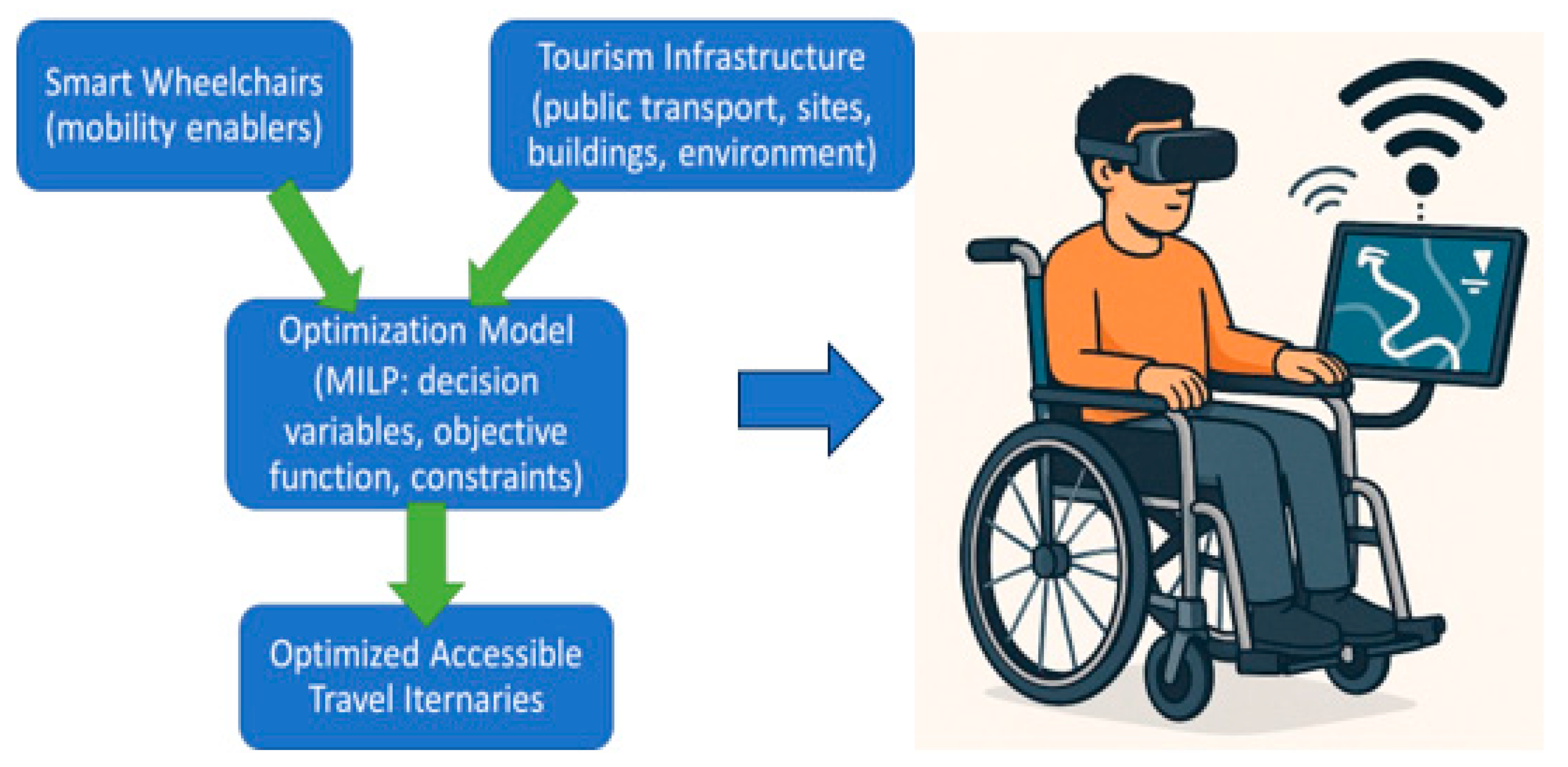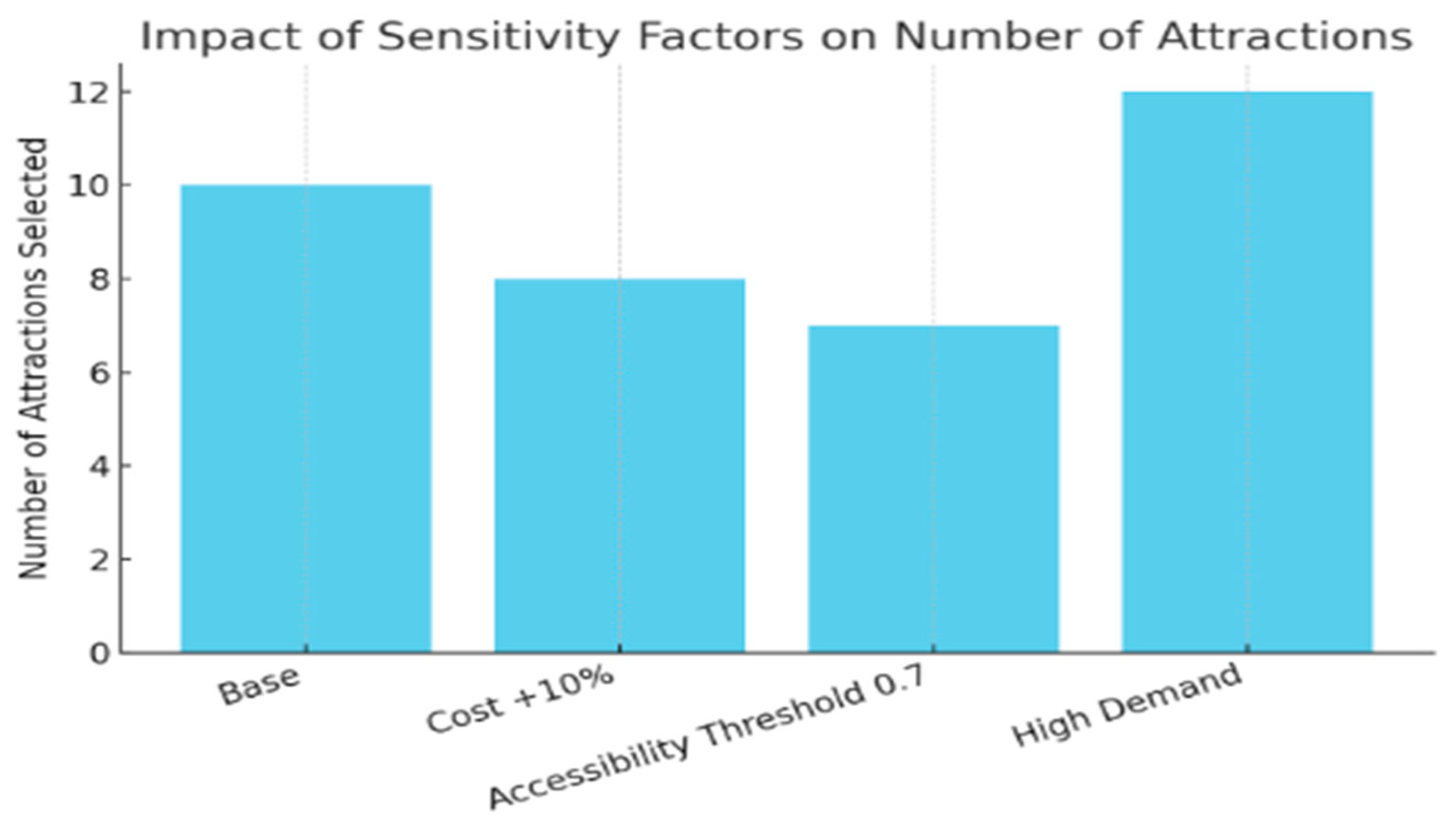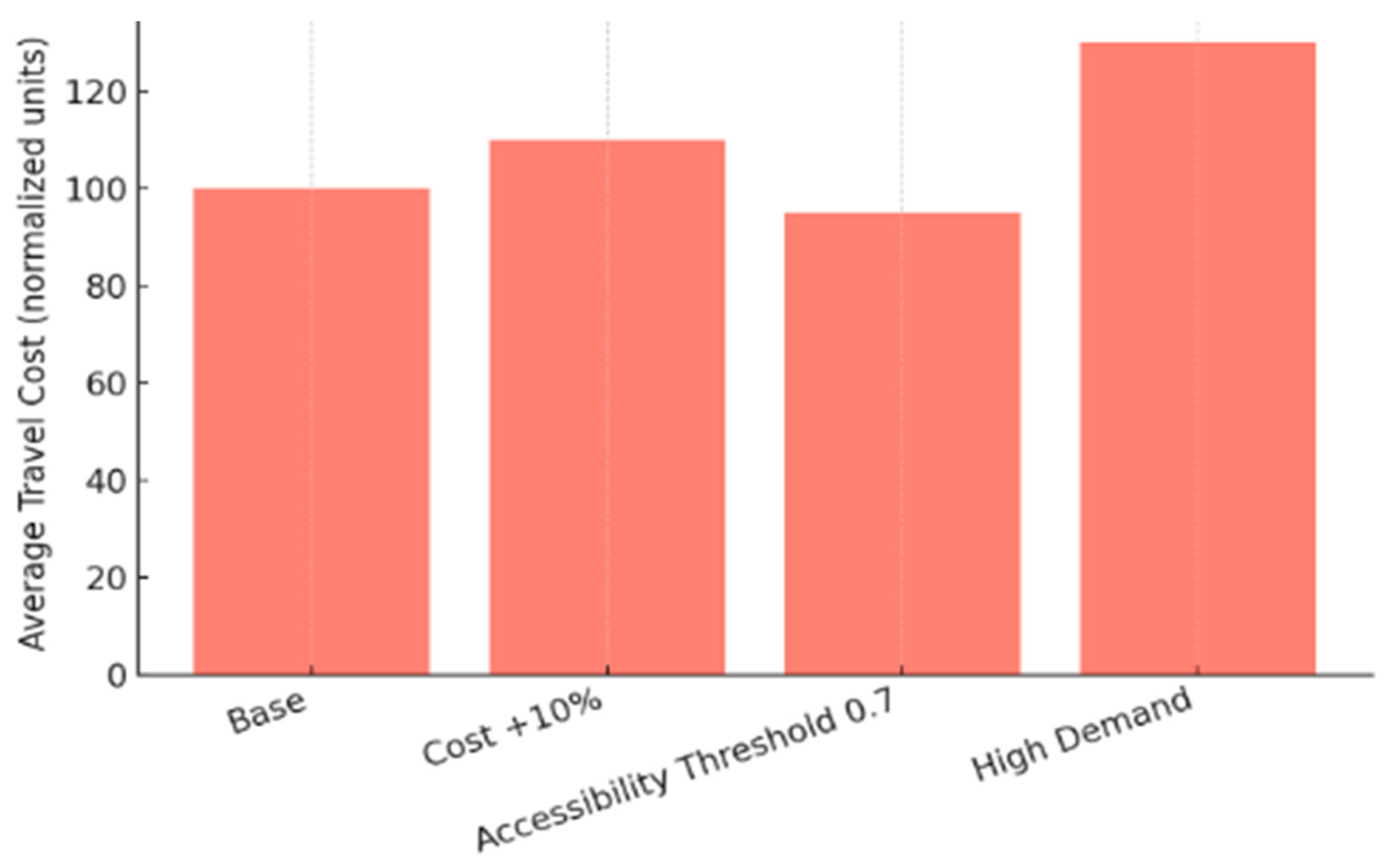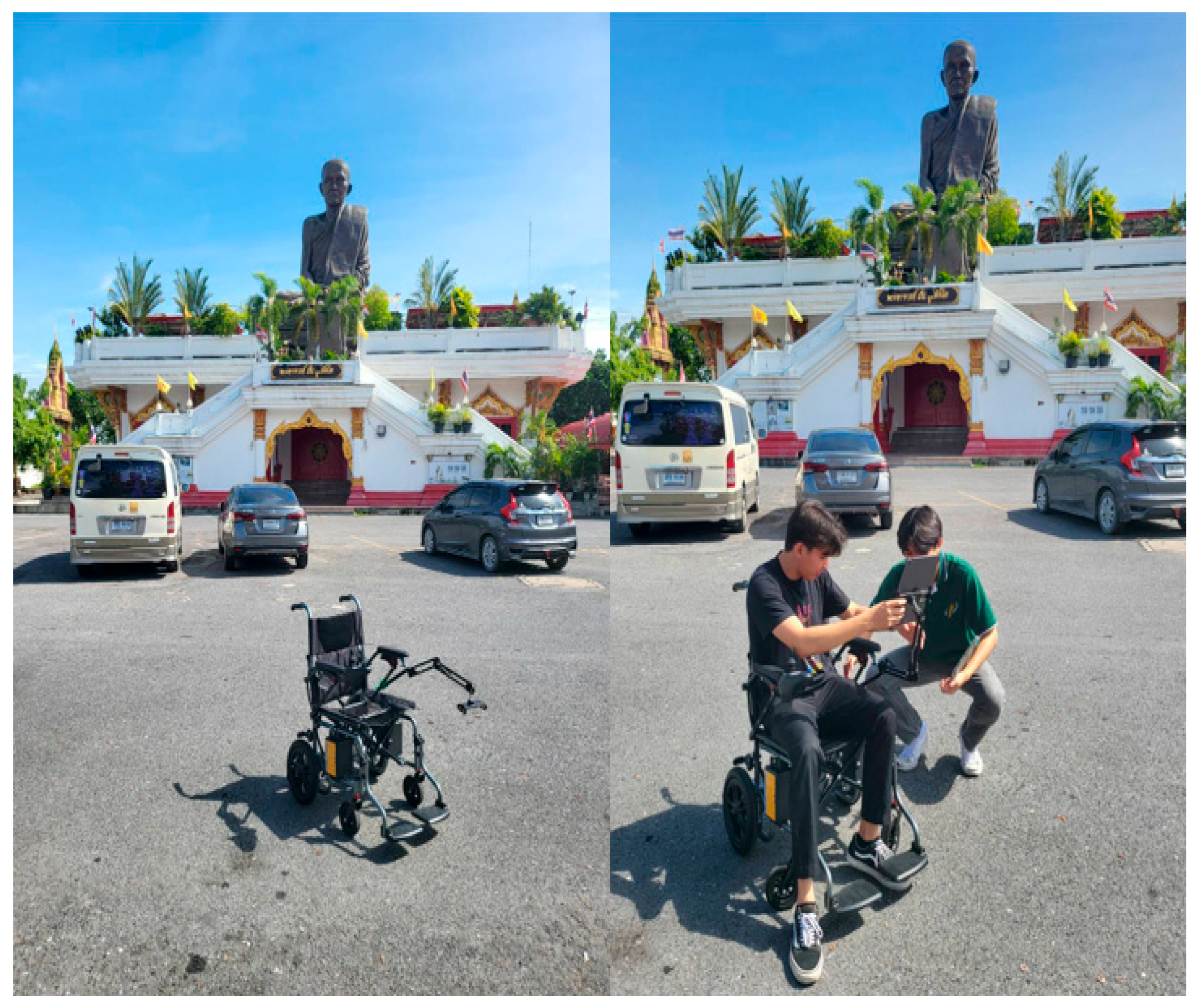To address the research objectives, this study develops a methodological framework that integrates conceptual problem definition, mathematical modeling, data collection, and a case study application. The methodology is structured in four main steps: first, the problem is defined within the broader context of accessible tourism and mobility ecosystems; second, a Mixed-Integer Linear Programming (MILP) model is formulated with decision variables, objective functions, and constraints reflecting accessibility and sustainability goals; third, data collection strategies are described, including surveys, GIS datasets, and secondary sources to build a comprehensive accessibility database; and finally, the proposed framework is applied to Thailand as a case study to evaluate its effectiveness in optimizing smart wheelchair travel itineraries.
3.2. MILP Model Formulation
AI platform was design to mitigate the limitations of the static national accessibility database managed by the Tourism Authority of Thailand and local operators, which requires verification by the Department of Tourism for accuracy, the proposed AI platform downloads data into a temporary database. This allows real-time processing to optimize travel itineraries for smart wheelchair users, ensuring personalized and accessible route planning. The temporary database integrates IoT-enabled sensor data from smart wheelchairs to dynamically update accessibility metrics, addressing real-time conditions such as temporary closures or environmental changes (e.g., flooded pathways) [
69].
The MILP model is designed to generate optimal itineraries for smart wheelchair users within Thailand’s tourism ecosystem.
Decision Variables: Binary variables xij represent whether route i → j is selected. Continuous variables capture travel costs, accessibility indices, and time of travel.
Objective Function: The multi-objective formulation aims to:
Note: where
cij is the travel cost,
aij is the accessibility score, and
ek represents environmental or cultural impact. Weights α,β,γ allow policymakers to prioritize among cost, accessibility, and conservation objectives [
78].
Here,
represents the travel cost (e.g., transportation and accommodation expenses) for route
,
is the accessibility score (e.g., a composite metric reflecting the presence of barrier-free pathways, accessible transport, and assistive facilities), and
captures the environmental or cultural impact associated with itinerary choices. The weights
,
, and
allow policymakers to adjust the prioritization among cost minimization, accessibility maximization, and environmental/cultural conservation, tailoring the model to specific policy goals [
78].
The term quantifies the environmental and cultural impact of the itinerary to promote sustainability. In practice, is a composite metric that includes factors such as the carbon emissions associated with transportation modes (e.g., favoring low-emission public transit over private vehicles), the ecological sensitivity of destinations (e.g., assigning penalties for routes that overburden fragile natural attractions like marine reserves or national parks), and the cultural preservation value of sites (e.g., prioritizing visits to heritage sites with sustainable management practices, such as those with visitor caps to prevent overcrowding). For example, a route visiting a culturally significant temple with eco-friendly infrastructure might have a lower value compared to a high-emission route to an over-touristed natural site. This term is derived from data in the national accessibility database, which includes environmental impact ratings and cultural significance scores for tourist sites, ensuring that the model promotes low-impact, culturally respectful travel itineraries.
By optimizing this multi-objective function, the MILP model generates itineraries that not only reduce costs and enhance accessibility but also minimize environmental degradation and support cultural preservation, aligning with Thailand’s broader sustainable tourism objectives and the United Nations Sustainable Development Goals (SDGs).
Constraints:
Transport Connectivity: All selected routes must follow feasible transport links, ensuring that the itinerary respects existing infrastructure (e.g., accessible public transit or roads). The connectivity constraints ensure that each selected node in the itinerary has exactly one incoming and one outgoing edge, forming a single, continuous path. However, the model does not mandate a full circuit visiting all available nodes. Instead, it allows for a subset of nodes to be selected based on constraints such as budget limits, accessibility thresholds, or user preferences. For instance, budget constraints may force the model to skip nodes with high travel costs or lower accessibility scores, prioritizing those that maximize the objective function within the given limits. This flexibility ensures practical itineraries tailored to the needs of smart wheelchair users, balancing inclusivity with resource constraints.
Wheelchair accessibility: Only routes and destinations with a minimum accessibility score are considered.
Budget limits: Total travel cost must not exceed budget thresholds.
Time windows: Visits to attractions must respect opening and closing times.
Flow conservation: Standard routing constraints ensure continuity of the itinerary.
Flow Conservation and Subtour Elimination: Standard flow conservation constraints ensure the continuity of the itinerary by requiring that the number of incoming edges equals the number of outgoing edges for each node in the selected path. To prevent subtours (disconnected loops that do not form a single continuous itinerary), the model incorporates subtour elimination constraints, adapted from classical vehicle routing problem formulations [
79]. Specifically, these constraints introduce auxiliary variables to enforce connectivity across the selected nodes, ensuring a single, coherent itinerary. For example, a common approach, as described in [
79], uses subtour elimination constraints based on the Miller-Tucker-Zemlin formulation, where a sequence variable is assigned to each node to prevent cycles that do not include the starting point. This ensures that the optimized itinerary forms a valid, connected route, whether it includes all nodes or a subset, depending on the constraints and objectives.
Smart Wheelchair Contribution in the Model
A distinctive feature of this study is the explicit integration of smart wheelchair mobility requirements into the MILP formulation. While conventional itinerary optimization models often prioritize cost or time, the inclusion of accessibility-specific variables enables the model to capture the real travel constraints faced by wheelchair users. Three elements are central to this contribution:
Accessibility Scores (aij)
The accessibility scores (aij) for each route and destination were derived using a standardized scoring rubric adapted from the Universal Design Index for Tourism (UDIT) [
80]. This rubber evaluates accessibility based on weighted criteria, including physical accessibility (e.g., presence of ramps, lifts, or step-free pathways, weighted at 40%), navigational aids (e.g., tactile paving, Braille signage, weighted at 30%), and availability of assistive facilities (e.g., accessible restrooms, designated wheelchair spaces, weighted at 30%). Data was collected through a combination of on-site surveys conducted by trained auditors, stakeholder consultations with disability advocacy groups, and GIS-based mapping of infrastructure features. Each criterion was scored on a scale from 0 (completely inaccessible) to 1 (fully accessible), and the composite aij score for each route or node was calculated as a weighted average, normalized to a 0.0–1.0 scale. For example, a route with full ramp access, partial tactile paving, and no accessible restrooms might receive an aij score of 0.65. Expert ratings from accessibility specialists were used to validate survey data, ensuring consistency and reliability. This methodology aligns with established standards for assessing tourism accessibility, enhancing the credibility of the scores used in the MILP model [
80].
Each potential link between nodes (e.g., airport–hospital, hospital–attraction) is assigned an accessibility score, ranging from 0.0 (inaccessible) to 1.0 (fully accessible). These values reflect the ability of smart wheelchair users to traverse a given route independently, informed by criteria such as step-free access, ramps or lifts, tactile paving, and restroom availability. The integration of aij allows the MILP to distinguish between theoretically possible routes and those that are genuinely inclusive.
Minimum Accessibility Threshold (Amin)
A feasibility constraint is introduced such that only nodes and links with aij ≥ Amin are eligible in the optimized itinerary. In the base case, Amin = 0.50, permitting both medium and high accessibility sites. In stricter scenarios, Amin is raised to 0.70, thereby excluding destinations that fail to meet higher standards. This reflects the practical advantage of smart wheelchairs, which can continuously sense environmental conditions and benchmark them against policy-defined thresholds.
Accessibility Weight (β) in the Objective Function
The objective function explicitly incorporates a weighted accessibility term as described in (1). Here, β governs the relative importance assigned to accessibility. By adjusting this coefficient, policymakers can explore trade-offs between cost minimization and inclusivity. This capability is enabled by the quantifiable data streams generated by smart wheelchairs, which provide evidence-based measures of travel quality.
Together, these features highlight how smart wheelchairs transform from being merely mobility devices into data-driven enablers of inclusive tourism planning. Their integration into the MILP model ensures that optimization results are not only cost-efficient but also socially equitable, aligning directly with sustainable development goals.
3.3. Smart Wheelchair
3.3.1. Hardware
The Smart Wheelchair, powered by electricity, reduces carbon dioxide emissions compared to traditional transport options, contributing to Thailand’s carbon neutrality goals. In collaboration with community-based tourism operators, the system prioritizes low-impact travel routes, aligning with the Green Tourism Initiative 2030. Preliminary estimates suggest a 10% reduction in emissions for optimized routes compared to conventional itineraries, though empirical testing is planned for future studies [
40].
The smart wheelchair is built with a carbon steel frame coated with anti-rust paint, ensuring durability and long-term usability. It weighs 33 kg and supports up to 120 kg load capacity. The wheelchair integrates a dual 24 V DC 250 W (Manufacturer: QUICKER (Tianjin) Sports Equipment Co., Ltd. (a leading OEM producer of electric bike and scooter components), Tianjin, China) motor for efficient propulsion, powered by a 24 V 12 Ah (Manufacturer: Chaowei Power, Dongguan, China) lead-acid battery that delivers up to 20 km of travel distance per charge, with easy charging through standard household outlets. The joystick controller is water-splash resistant, equipped with five adjustable speed levels and a sleep mode for energy saving. Safety features include an automatic electronic brake system, manual brake lever, anti-tilt wheels, horn, and seatbelt. The wheelchair runs on 8-inch front wheels and 16-inch rear wheels, capable of climbing slopes up to 12° at a maximum speed of 6 km/h. The seat is made of nylon mesh fabric, which is breathable and detachable for washing.
Figure 4.
Hardware diagram of the smart wheelchair.
Figure 4.
Hardware diagram of the smart wheelchair.
Carbon steel frame with removable nylon-mesh seat for strength and comfort. 24 V 12 Ah lead-acid battery powering dual 24 V DC 250 W motors (6 km/h, 20 km range, 12° slope). Microcontroller unit (MCU) for motor control, brake, and safety management. Joystick controller with 5 speed levels, waterproofing, and sleep mode. Integrated sensors, GPS, and communication modules for obstacle detection, navigation, and telemetry.
3.3.2. Software
The operational process of the smart wheelchair can be divided into three stages: Initialization and Setup: The battery is charged via household power. The system initializes with a safety check (brakes, joystick calibration, and sensor readiness).
Operation and Navigation: The user controls movement via the joystick, with five adjustable speed modes. Software algorithms ensure smooth acceleration, automatic braking on slopes, and obstacle avoidance. GPS-based navigation assists in route planning, particularly in tourism or outdoor applications.
Safety and Shutdown: Automatic braking activates when the joystick is released. The system enters sleep mode when idle, reducing power consumption. After use, the wheelchair can be folded for storage or transport. This process ensures ease of use, safety, and portability, enhancing independence and mobility for elderly users, patients, or people with disabilities.
Figure 5.
Smart wheelchair prototype in accessible tourism attraction in Thailand [
8,
75,
76].
Figure 5.
Smart wheelchair prototype in accessible tourism attraction in Thailand [
8,
75,
76].
3.3.3. Process
The operational process of the smart wheelchair can be divided into three stages: Initialization and Setup: The battery is charged via household power. The system initializes with a safety check (brakes, joystick calibration, and sensor readiness).
Operation and Navigation: The user controls movement via the joystick, with five adjustable speed modes. Software algorithms ensure smooth acceleration, automatic braking on slopes, and obstacle avoidance. GPS-based navigation assists in route planning, particularly in tourism or outdoor applications.
Safety and Shutdown: Automatic braking activates when the joystick is released. The system enters sleep mode when idle, reducing power consumption. After use, the wheelchair can be folded for storage or transport. This process ensures ease of use, safety, and portability, enhancing independence and mobility for elderly users, patients, or people with disabilities.
3.4. Data Collection
To parameterize the model, a national accessibility database was developed, integrating multiple data sources:
Database scale: The national accessibility database covers a substantial scope, including 250 nodes (representing key tourism sites such as cultural landmarks, natural attractions, airports, and medical facilities) and 1200 edges (representing feasible transport links between nodes) across 10 major cities in Thailand, including Bangkok, Chiang Mai, Phuket, and secondary cities like Ayutthaya and Sukhothai. This scale ensures robust coverage of Thailand’s tourism infrastructure, enabling the MILP model to generate practical and inclusive itineraries.
Public transport systems: Data from metro, bus, and intercity rail operators regarding wheelchair-accessible vehicles and stations.
Public buildings and attractions: Surveys of cultural sites, museums, parks, and temples, recording accessibility features (ramps, lifts, signage).
Parks and natural areas: GIS datasets on protected areas and national parks, enriched with field audits for accessible trails and facilities.
Secondary sources: Government reports, published studies, and datasets on medical and wellness tourism infrastructure [
35].
Spatial data were geocoded and integrated into a GIS platform, providing the backbone for the MILP input matrices (nodes, edges, travel times, and accessibility indices). Similar approaches using GIS-linked MILP formulations have proven effective in sustainable transport planning and urban accessibility studies [
81].
Figure 6.
Smart Wheelchair Evaluation and FAM Trip [
8].
Figure 6.
Smart Wheelchair Evaluation and FAM Trip [
8].
Additionally, the evaluation of the smart wheelchair was conducted during a Familiarization (FAM) Trip in Ayutthaya Province, involving testing with 30 participants, including tourists and users with disabilities, in collaboration with a tourism company that facilitates travel for tourists from Europe, to assess the performance and efficacy of the Smart Wheelchair.
3.5. Case Study: Thailand
Thailand serves as an ideal case study for accessible tourism, given its heavy reliance on tourism as a key economic pillar and its ambition to establish itself as a global medical and wellness tourism hub. Before the pandemic, the country welcomed over 39 million international visitors annually, with medical and wellness tourism emerging as a fast-growing segment [
8]. Despite this, accessibility gaps persist across major destinations like Bangkok, Chiang Mai, and Phuket, as well as in secondary cities, limiting the inclusivity of its tourism offerings [
8]. This case study incorporates Thailand’s tourism infrastructure into a Mixed-Integer Linear Programming (MILP) framework through the following steps:
Mapping multimodal public transportation networks in Bangkok and Chiang Mai to assess connectivity for accessible travel.
Incorporating key cultural and heritage sites, such as temples and UNESCO-listed locations, to ensure inclusive access to iconic attractions.
Including natural attractions like national parks and coastal areas to address diverse tourism experiences.
Integrating accessibility survey data into the model to reflect real-world conditions for mobility-impaired travelers.
To support the MILP model’s optimization, travel times and networks were modeled using GIS-based road and public transportation network data sourced from Thailand’s national accessibility database and open-source GIS platforms [
82]. Travel times were calculated based on real-world road network distances, public transit schedules, and average travel speeds for accessible transport modes (e.g., low-floor buses, wheelchair-accessible taxis), accounting for factors like traffic conditions and transfer times at transport hubs. For routes lacking precise data (e.g., in secondary cities), travel times were estimated using average speeds derived from regional transportation studies, validated through field audits during the Familiarization (FAM) Trip in Ayutthaya [
8,
82]. This approach ensures accurate and realistic inputs for the MILP model, enabling the generation of practical itineraries for smart wheelchair users.
By applying the MILP framework to Thailand’s national accessibility database, this study evaluates optimized travel itineraries for smart wheelchair users, analyzing trade-offs among travel costs, accessibility levels, and the preservation of cultural and environmental assets. Additionally, the case study identifies policy measures needed to bolster Thailand’s role as a leader in inclusive medical tourism [
83].
